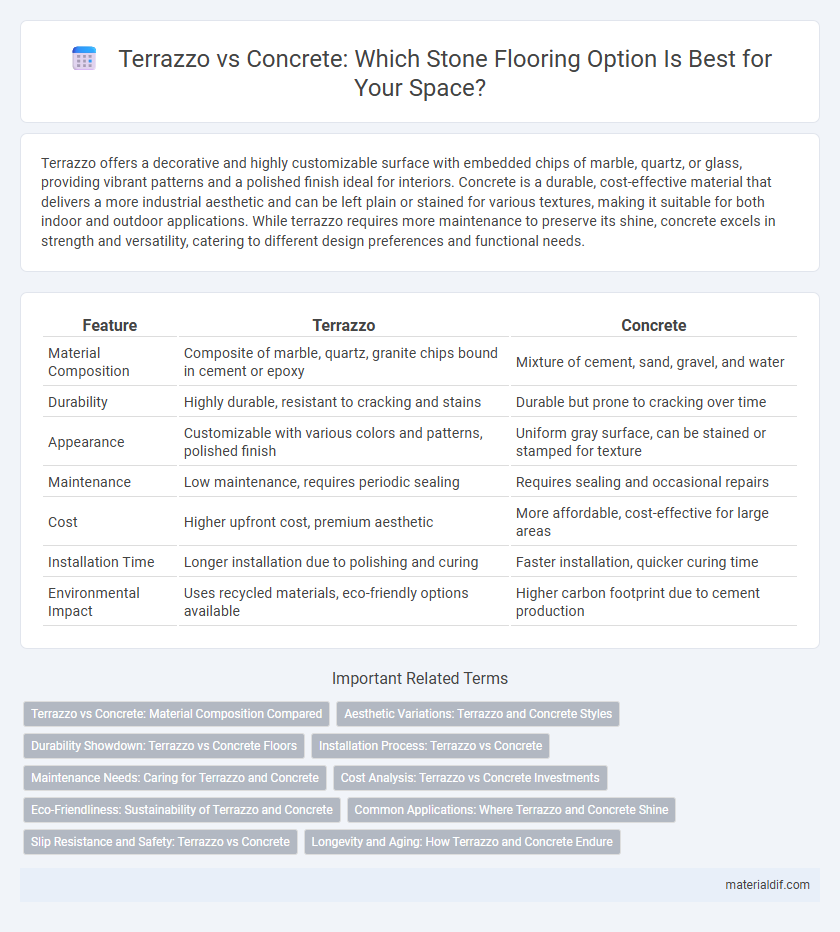Terrazzo offers a decorative and highly customizable surface with embedded chips of marble, quartz, or glass, providing vibrant patterns and a polished finish ideal for interiors. Concrete is a durable, cost-effective material that delivers a more industrial aesthetic and can be left plain or stained for various textures, making it suitable for both indoor and outdoor applications. While terrazzo requires more maintenance to preserve its shine, concrete excels in strength and versatility, catering to different design preferences and functional needs.
Table of Comparison
| Feature | Terrazzo | Concrete |
|---|---|---|
| Material Composition | Composite of marble, quartz, granite chips bound in cement or epoxy | Mixture of cement, sand, gravel, and water |
| Durability | Highly durable, resistant to cracking and stains | Durable but prone to cracking over time |
| Appearance | Customizable with various colors and patterns, polished finish | Uniform gray surface, can be stained or stamped for texture |
| Maintenance | Low maintenance, requires periodic sealing | Requires sealing and occasional repairs |
| Cost | Higher upfront cost, premium aesthetic | More affordable, cost-effective for large areas |
| Installation Time | Longer installation due to polishing and curing | Faster installation, quicker curing time |
| Environmental Impact | Uses recycled materials, eco-friendly options available | Higher carbon footprint due to cement production |
Terrazzo vs Concrete: Material Composition Compared
Terrazzo consists of a composite of marble, quartz, granite, or glass chips embedded in a cement or epoxy binder, offering customizable aesthetics and a polished finish. Concrete is primarily composed of cement, water, sand, and aggregate, providing structural strength but a more utilitarian appearance. The material composition of terrazzo allows for greater design versatility, while concrete emphasizes durability and cost-effectiveness.
Aesthetic Variations: Terrazzo and Concrete Styles
Terrazzo offers a rich array of aesthetic variations, featuring vibrant chips of marble, glass, and quartz that create intricate, mosaic-like patterns with customizable colors and textures. Concrete, on the other hand, provides a more minimalist and industrial look, with options for stamping, staining, or polishing to enhance its natural gray tones and surface textures. Both materials allow significant design flexibility, but terrazzo excels in decorative detail while concrete emphasizes sleek and modern simplicity.
Durability Showdown: Terrazzo vs Concrete Floors
Terrazzo floors offer exceptional durability due to their composite structure of marble, quartz, and glass chips bound with cement or epoxy, making them resistant to cracking and wear over time. Concrete floors, while highly durable and capable of supporting heavy loads, may be prone to surface cracking and require sealing to prevent moisture damage and staining. The long-term resilience of terrazzo often surpasses concrete in high-traffic areas, providing a more maintenance-free and aesthetically lasting flooring solution.
Installation Process: Terrazzo vs Concrete
Terrazzo installation involves embedding marble, quartz, or glass chips in a binder, requiring precise layering and polishing for a smooth finish, which can extend project timelines. Concrete installation is typically faster, involving pouring, leveling, and curing, but may require additional sealing to enhance durability and appearance. Terrazzo demands skilled craftsmanship for intricate designs, while concrete offers straightforward application, making it suitable for large-scale projects.
Maintenance Needs: Caring for Terrazzo and Concrete
Terrazzo requires regular sealing and polishing to maintain its glossy finish and prevent stains, while concrete demands periodic sealing to avoid cracking and surface damage caused by moisture and wear. Terrazzo surfaces benefit from gentle cleaning agents and microfiber mops to preserve color vibrancy, whereas concrete floors often need a pH-neutral cleaner to prevent etching and surface degradation. Both materials respond well to prompt spill cleanup and routine maintenance schedules to extend durability and aesthetic appeal in high-traffic areas.
Cost Analysis: Terrazzo vs Concrete Investments
Terrazzo flooring generally demands a higher initial investment compared to concrete due to its labor-intensive installation and premium materials like marble chips and epoxy resin. Concrete, while typically less expensive upfront, may incur additional costs over time from sealing, polishing, or repairs, especially in high-traffic areas. Long-term cost analysis favors terrazzo's durability and low maintenance, offsetting its upfront expense through extended lifecycle performance.
Eco-Friendliness: Sustainability of Terrazzo and Concrete
Terrazzo offers superior eco-friendliness by incorporating recycled materials such as glass, marble, and metal chips, reducing waste and promoting sustainability. Concrete's environmental impact stems from high carbon emissions during cement production, though advances in low-carbon concrete and supplementary cementitious materials help mitigate these effects. Choosing terrazzo or sustainably produced concrete depends on balancing durability, recycled content, and carbon footprint for environmentally conscious construction.
Common Applications: Where Terrazzo and Concrete Shine
Terrazzo excels in commercial spaces like airports, hospitals, and schools due to its durability and customizable aesthetic, often incorporating marble, quartz, or glass chips for intricate designs. Concrete dominates industrial and outdoor applications such as driveways, sidewalks, and warehouse floors because of its strength, cost-effectiveness, and ease of installation. Both materials are also popular in residential settings, with terrazzo favored for decorative flooring and concrete used in patios and foundations.
Slip Resistance and Safety: Terrazzo vs Concrete
Terrazzo surfaces offer enhanced slip resistance when embedded with aggregates like quartz or granite, creating a textured finish that reduces slip hazards compared to smooth concrete. Concrete can be treated with additives or textured finishes to improve safety, but may still become slippery when wet or polished. Choosing terrazzo for flooring in high-traffic or wet environments increases safety by providing a more slip-resistant surface.
Longevity and Aging: How Terrazzo and Concrete Endure
Terrazzo boasts exceptional durability due to its composition of marble, quartz, or glass chips embedded in cement or epoxy resin, allowing it to resist cracking and wear over decades with minimal maintenance. Concrete, while strong and versatile, tends to be more susceptible to surface erosion, cracking, and discoloration from environmental exposure and weathering when not properly sealed. The longevity of terrazzo surfaces often surpasses concrete, maintaining aesthetic appeal and structural integrity through aging thanks to its dense, polished finish.
Terrazzo vs Concrete Infographic

 materialdif.com
materialdif.com